Jan-09-19
 | | KEG: A true heavyweight showdown. Going into this 10th round contest, Schlechter was tied for first with Pillsbury just a half-point ahead of Maroczy. Since Pillsbury and Maroczy won their 10th round games, Schlechter also had to win to keep pace. Meanwhile, Janowski had overcome his bad start and moved into a tied for sixth place with Showalter two points behind Pillsbury and Schlechter. To have any chance to catch up, Janowski needed a win in this game. Schlechter and Janowski had squared off before: at Leipzig 1984 (a draw); Hastings 1895 (Janowski won); Nuremberg 1896 (Janowski won); Budapest 1896 (Schlechter won); Berlin 1897 (a draw); Vienna 1898 (one win for Janowski and a draw); London 1899 (two wins for Janowski); Paris 1900 (Schlechter won). In their game at Munich 1900, they had a close contest until Janowski went astray beginning on his 22nd move. The tactics became very difficult and exciting, but Janowski then erred and Schlechter obtained an overwhelming--and clearly won--position. Thereafter, play got sloppy, Schlechter missing some fast ways to close out the game and Janowski playing listlessly as he dragged out play far longer in a hopeless position than just about any of his peers could have stomached. 1. e4 e5
2. Nf3 Nc6
3. Bb5 a6
4. Ba4 d6
The Modern Steinitz Defense to the Ruy Lopez.
5. 0-0
One of many known and accepted ways to meet the Modern Steinitz Defense. Among the other well-known options are 5. BxN+. 5. c5, 5. c3, and 5. d4. The choice is generally a matter of style. 5... Bd7
Also one of many reasonable possibilities. Other choices are 5...Bg4; 5...Nf6; and 5...Be7. 6. c3
This could transpose to lines beginning with 5. c3. 6. Nc3, 6. c4, and 6. d4 are also reasonable options. 6... Nf6
6...Be7 and 6...g6 are also OK. 6...Nge7 is also often played here. 7. Re1
7. d4 and 7. Bc2 are also good here and yield a slight edge to White. The text has been played by--amongst others--Maroczy, Schlechter, Smyslov, and Karpov. 7... g6
One of many possible plans for Black. Other ideas begin with 7...Be7 and 7...b5. The text has been played by Keres, Hort, and Robert Byrne. 8. d4
As played here by Maroczy, Ivkov, and Karjakin. 8... Bg7
Reaching the following position:

click for larger viewCarlsen, Caruana, and Ivanchuk (and others) have reached this position as Black. White enjoys a small advantage here. How to follow up? 9. Nbd2
Though this has been tried, it seems less promising than 9. d5. 9. h3 (to keep Black off g4) is another good possibility (but has not been tried so far as I can find). As became clear from Janowski's next move, his plan was adopt the Lopez Knight maneuver of Nd2--f1 and then e3 or g3. 9... 0-0
10. Nf1
This is a typical Knight deployment by White in the Ruy Lopez, but it doesn't seem effective here. several varying moves involving a variety of plans seem better here: 10. BxN, 10.. h3, or even 10. Bc2. 10... Nh5?!
10...exd4 or 10...b5 seem indicated. But--as will soon become clear--Schlechter had some big plans for the King-side. The text may or may not be sound (it doesn't seem to get Black very far with best play by White) but it does make the game the thrilling contest it soon became. 11. h3 h6
Not bad, but 11...Nf4 or 11...Re8 seem more in keeping with hit last move. 12. d5
Premature. 11. Be3 or 12. Bc2 were best here.
12... Ne7
13. Bc2 Re8
14. N1h2
A strange posting for this Knight. The position was now: 
click for larger viewA complicated position with chances for both sides. From here, as I will discuss in my next post on this game, both sides sought to attack and the game remained in the balance until Janowski went astray beginning on his 22nd move. |
|
Jan-09-19
 | | KEG: Post II
14... Nf4
Schlechter doubles down on his 10th move rather than the less committal and solid 14...Nf6; 14...b5; or 14...c6. 15. BxN
One might have expected 15. Be3 or 15. a4 from Janowski in order to keep his beloved two Bishops. But Janowski here evidently decided that exchanging Bishop for Knight would create weaknesses for Black that would compensate for giving Schlechter the two Bishops. 15... exB
16. Qd2
Connecting his Rooks and putting the question to Schlechter's f4 pawn. 16... g5
Forced. The position was now:
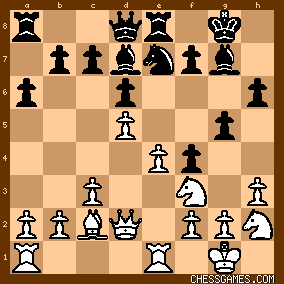
click for larger viewA double-edged position. The key question here was whether Schlechter was over-extended and what threats he could pose on the King-side. 17. e5!
The Karpovian 17. Nd4 may be best, but I like Janowski's uncompromising strategy. This made the game--though things in fact ultimately did not work out well for Janowski (because of later errors). 17... dxe5
18. Nxe5 Bf5
Schlechter also was taking no prisoners. 18...Be6 (exploiting the fact that the d-pawn would then be pinned) was perhaps safer. This left:
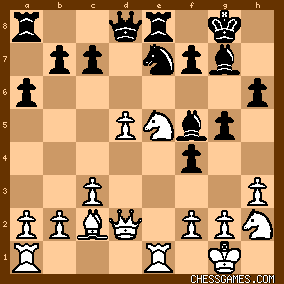
click for larger viewA difficult position to evaluate. Janowski here faced a fascinating panoply of possible plans. 19. Bb3
Solid but not what I would have expected from the normally aggressive Janowski. The Tournament Book's suggested 19. BxB is also solid and non-enterprising. Stronger was 19. Rad1, bringing the a1 Rook to the fight. If Schlechter then traded Bishops (probably best play) Janowski would have the initiative and the better chances. The exciting line was 19. Nxf7!? KxN 20. RxN+ RxR 21. BxB, leaving: 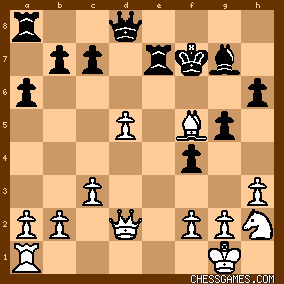
click for larger viewWho's on top here? Unclear, isn't it. [Fritz rates it a 0.00; Stockfish as 0.25). Tactics would have ruled, so--yet again--I am surprised that Janowski avoided this line. Perhaps he had developed a strong respect for Schlechter. Let's return to the actual game:
19... Nc8!
Another demonstration, if such were truly needed, of Schlechter's developing positional genius. With the text, any notion Janowski may have harbored about playing Nxf7 was now off the table. 20. Nhf3 Nd6
The point of Schlechter's prior move. f7 was now secure. 20...BxN was another possibility, but I like Schlechter's approach that combined defense with offense. 21. Bc2
A backtracking Janowski was now prepared to trade Bishop. 21... Qf6
The position was now:

click for larger viewTo this point, chances were about even. But in the above position, as I will discuss in my next post on this game, Janowski lost his way and was soon lost and reduced to fighting a desperate struggle against the inevitable. |
|
Jan-10-19
 | | KEG: Post III
22. Ng4?
With this mistake, Janowski's small remaining chances of catching the leaders at Munich 1900 cameto an end. The Knight at e5 was Janowski's key to counterplay (e.g., keeping the Black Queen at bay and off g6 and f5). With the text, Schlechter's attack gained steam and Janowski's ran out of gas. 22. c4 or 22. Re2 or perhaps even 22. Bd3 would have maintained the sharp equilibrium. 22... Qg6
23. BxB QxB
24. Rad1 Rad8
24...h5 would also have been good.
The position was now:

click for larger viewAs it obvious, all the chances now lie with Black. 25. b3?
This weakening move only made matters worse for Janowski. He might have tried to hang on with 25. c4 or 25. RxR+ or maybe 25. a4. Now, Janowski's position could have been overrun. 25... h5!
The Black Knight that had stood strong on e5 a couple of moves ago now is consigned to h2. 26. Ngh2 Ne4?
This did not necessarily relinquish Schlechter's bind on the position, but he could have won material--and the game in very short order--with 26...RxR+ and 27...Nb5! The text superficially looks strong, but in fact gave Janowski some chances. 27. Qc2 Qg6
28. c4 f5!
A powerful thrust that left Janowski with only one legitimate hope for survival, the position now being: 
click for larger viewJanowski--the great lover of Bishops--must have envied Schlechter's powerful cleric at g7. 29. Nd4?
29. h4 was his only real chance, but...
29... g4?
Lovely as Schlechter's Bishop was on g7, here he could have won by trading it off with 29...BxN 30. RxB g4! and White gets slaughtered on the King-side. The text gave Janowski some serious chances for counterplay. 30. hxg4?
30. Ne6! would have given Schlechter fits.
30... hxg4?
Again missing the chance to trade off the dangerous d4 Knight. If 30...BxN 31. RxB hxg4 is crushing. And if Janowski here had tried the intermediate move 31. gxf5 Bxf2+ would win. With the text, Janowski had a second chance to play Ne6, and this time he didn't miss the opportunity. 31. Ne6!
His only chance, but a good one. Suddenly, a win for Black looks problematic at best, the position now being: 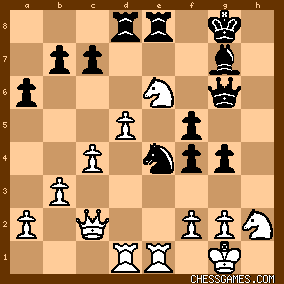
click for larger view31... g3
31..,f3 was probably better.
32. fxg3 fxg3
33. Nf3 Rd7
This left:

click for larger viewJanowski was far from out of the woods, but his stock had clearly risen from a few moves ago. In the diagrammed position, however, and as I will discuss in my next post on this game, Janowski blew his chances and Schlechter cleaned up. |
|
Jan-10-19
 | | KEG: Post IV
In the diagrammed position with which I ended my last post, Janowski's Knight on e6 gave him real chances of survival. But here he erred badly, and his remaining chances were gone: 34. Nf4?
Why give up his strong Knight position? Among other things, it kept the e-file closed so that the White King could seek shelter beginning with 34. Kf1 (probably best here). 34... Qh6
34...Qg4! would have been even stronger.
35. Nh3
The position was now:
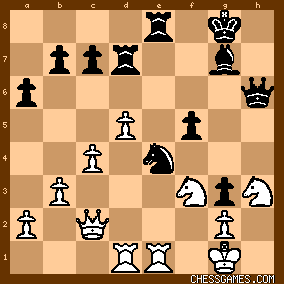
click for larger viewPlay for the last several moves had been spotty at best. But here Schlechter found a remarkable quiet move that reduced Janowski to helplessness: 35... Bf8!
Schlechter's positional genius at work. The Bishop now moves to the a7..g1 diagonal where it again causes havoc for White. 36. Nd4
Janowski should probably have run for his life beginning with 36. Kf1. Instead, he walked into a nasty pin. 36... Bc5
36...Bb4 also probably wins for Black, but the logic of the text is undeniable. The position was now:

click for larger viewAs the Tournament Book pointed out, 37. Kf1 was Janowski's only chance. 37. Qb2??
Now the floodgates opened.
37... Rde7!
38. Rd3?
Janowski must have been frustrated and confused. 38. b4 was the only even small remaining chance. 38... f4
This wins, but 38...Nf2! was immediately decisive: e.g., 39. Rxg3+ Ng4 40. Rf1 Re4 and the game would be over. 39. Kf1?
Too late! He should have tried 39. d6 if he wanted to play on. The position was now:
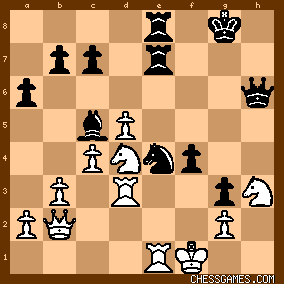
click for larger view39... Nd2+
This wins material and ultimately the game, but Schlechter had a faster win with 39...BxN 40. RxB f3! 40. QxN
Janowski had to part with his Queen to stay in the game. 40... RxR+
41. QxR RxQ+
42. KxR BxN
This wins, but 42...Qf6 was even stronger.
43. RxB
The dust had settled, and the resulting position was: 
click for larger viewThis Queen versus Rook and Knight ending is a win for Schlechter, but--as I will discuss in my next post on this game--he made heavy weather of the win, and the game was to drag on for another 18 moves. Schlechter never lost his winning advantage from here, but he seemed to be playing on auto-pilot (and Janowski seemed to have lost interest in the game). In fairness, I note that these endings are difficult and unfamiliar to most players. |
|
Jan-10-19
 | | KEG: Post V
Looking solely at the moves played, the conclusion of this game was far from impressive. Schlechter consistently missed the most forcing lines (though never losing his winning advantage), and Janowski's play often seemed indifferent. From what I have read about Janowski, I suspect that he was sulking and conveyed body language to Schlechter such that the latter knew the game was over. But all this is not much more than a guess, perhaps inspired by my deep regard for Schlechter and astonishment at his less than accurate play as he completed his win here. Another factor may have been time pressure (there likely being time controls at moves 45 and 60 at Munich 1900). 43... f3
This winds up losing both Black King side pawns. Correct was either 43...Qf6 or 43...Qg7 or 43...Qh8. Play could then have continued 43...Qf6 44. Rxf4 Qa1+ 45. Ke2 Qxa2+ 46. Kf3 Qxb3+ 47. Kg4 b5 48. cxb5 axb5 with a clear win for Black. 44. Rg4+ Kh8
45. Rxg3
The position was now:
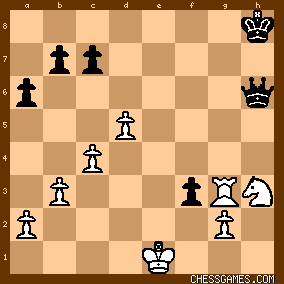
click for larger viewSchlechter could now have won with 45...Qe3+ 46. Kf1 Qe2+ 47. Kg1 Qe1+ 48. Kh2 f2 49. Nxf2 QxN. But instead he played: 45... fxg2
As so the game puttered on.
46. Ke2 g1(Q)
46...b5 was better. The game is still won for Schlechter even after the text, but now became more of a potential struggle. 47. NxQ Qh2+
48. Kf3 Qxa2
This left:

click for larger viewStill a win for Black? For sure. But a quick and easy win. Hardly. But from here on Janowski made little real effort. Within the next ten moves, Janowski managed to lose all three of his pawns while not capturing any of Schlechter's: 49. Kf4
49. Kg4 was better
49... a5
50. Nf3?
Throwing away his b-pawn. 50. Nh3 obviously would have given Janowski better practical chances. 50... Qxb3
Happily gobbling up the b-pawn Janowski had decided to leave hanging. The position was now:
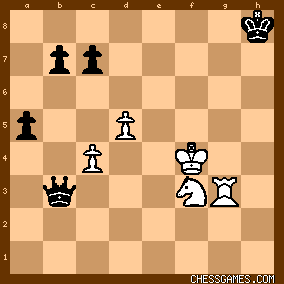
click for larger view51. Nd2?
"?"--Tournament Book.
Feeble. 51. Ne5--as the Tournament Book pointed out--was the only way to keeo the game going. 51... Qc2
This works (and wins another pawn), but 51...Qb4 followed by the march of the a-pawn was far stronger. 52. Ne4 Qxc4
53. Ke5
53. Rh3+ was the best left to him.
53... Qe2
54. Kf5 a4
55. Rc3 Qh2
This left:
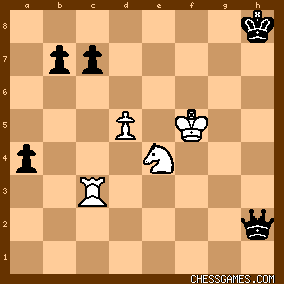
click for larger viewThe result from this point was obviously not in doubt. I will cover the remainder of the game in my next post on this game. |
|
Jan-10-19
 | | KEG: Post VI
The finale was brutal but not pretty.
56. Ng5?
56. Nf6 or 56. Ke6 would not have saved the game, but they would at least have avoided the coming fork. 56... Qd2
This fork attacked just about everything, and picked up Janowski's remaining pawn. 57. Rh3+ Kg8
58. Ne6 Qxd5+
Why play on in this position?:

click for larger viewJanowski's position is so hopeless that Schlechter could even trade Queen for Rook and still win easily. But Janowski played on. He was hoping for a miracle mating net. 59. Kf6 Qg2
60. Rh5
Praying to be able to set up a mating net. Maybe this would have succeeded against a beginner. But against Schlechter? 60... a3
"!"--Tournament Book.
Talk about a won game:

click for larger view61. Ra5
Janowski could have mated a beginner playing White. (e.g., 61...Qc2 62. Ra8+ mates in four). But even this absurd hope was extinguished by Schlechter's next move. 61... Qb2+
Now even Janowski realized the game was over.
0-1 |
|
|
|
|





































